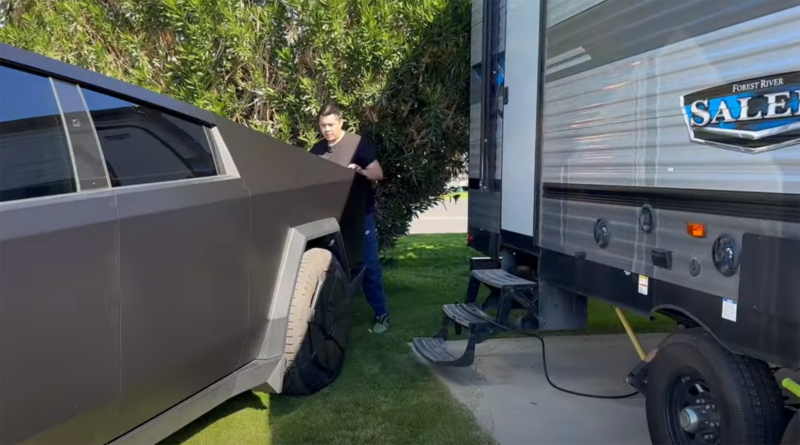Tesla Cybertruck Can’t L2 Charge While Powering A Camper, Yet
A recent video at the Butter_EV YouTube Channel shows that you can do some really cool things with large EV batteries at campsites with a travel trailer, like power an RV’s air conditioning and other systems. This would be especially useful for “boondocking” — camping away from utility connections at RV parks. But … there’s one limitation he ran into that doesn’t make a lot of sense.
For the first part of the video, he explains what kind of experiment he’s trying out: to plug his RV into the truck’s 240V plug in the bed and power the RV while charging the truck. This would be excellent because it would allow the truck to pick up leftover power at an RV park and charge as fast as it can.
He has a mid-sized bumper-pull travel trailer. I didn’t catch the exact model number to know the actual empty weight, but it has two axles, so it’s probably in the 5000–7000 pound range. It has two air conditioners, and that means a lot of power draw. He starts by proving that he’s got the ACs running on the site’s 50-amp power supply.
Next, he goes to the pedestal and unplugs the RV, instead connecting a Tesla Mobile connector to pull 40 amps of power from the pedestal and charge the truck. He then takes the RV’s 50-amp extension to the bed of the Cybertruck, leaving it there while he plugs the truck in to verify that it’s getting a Level 2 charge from the RV pedestal. The truck’s display shows 32 amps (the mobile connector’s maximum, apparently) at 241 volts.
He then tries to turn the outlets on, but it won’t let him until he unplugs the charger. He turns the outlets on, gets the trailer plugged into the truck’s 240V outlet, and then has to reset the breaker. At that point, the AC units are running in the camper powered from the Cybertruck. Then, he plugs the truck into the charger again, but the Cybertruck kills the bed plugs, and the camper’s ACs quit.
Tesla might have a really good reason for doing this. It’s possible that if you pulled more power from the vehicle than you put in, you could wake up to a dead truck instead of charging it up. So, to avoid confusion, Tesla may have decided to discourage this.
But the feature may be coming to the truck in a future update, at least if the rumor mill is true. Multiple YouTubers who seem credible say that the truck is going to get the ability to pick up power while releasing it soon.
However, this feature might not be the most useful at RV parks. Most 50-amp pedestals have a 50-amp plug, a 30-amp plug, and at least one 20-amp plug. Most people charging an EV and powering an RV prefer to plug the EV into the 50-amp plug and power the RV from the 30-amp plug. Most RVs that you’d actually want to tow with an EV wouldn’t exceed the 30 amps, but you might have to be careful if you’re running AC and a microwave at the same time, as 30-amp travel trailer plugs are 120 volts and not 240 (no second 120V leg, making the 30 amps half as powerful as the 240V plug).
So, at the end of the day, it might just be better to plug both the truck and the RV into the pedestal.
Featured image: a screenshot from the embedded video.
Chip in a few dollars a month to help support independent cleantech coverage that helps to accelerate the cleantech revolution!
Have a tip for CleanTechnica? Want to advertise? Want to suggest a guest for our CleanTech Talk podcast? Contact us here.
Sign up for our daily newsletter for 15 new cleantech stories a day. Or sign up for our weekly one if daily is too frequent.
CleanTechnica's Comment Policy
